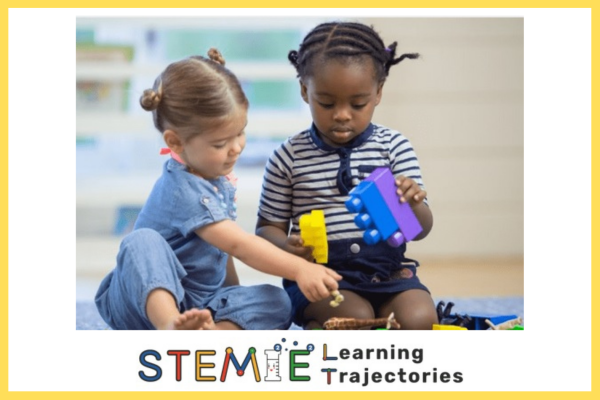
STEMIE launches new learning trajectories website
As part of its commitment to developing and enhancing engagement in STEM (science, technology, engineering, and mathematics) learning opportunities for young children with disabilities (birth to five), the STEM Innovation for Inclusion in Early Education (STEMIE) Center has launched a new learning trajectories website. This site is a culmination of the work of the Center since it began in 2018. This work builds upon the math learning trajectory work of STEMIE leaders Doug Clements and Julie Sarama, from the University of Denver, to expand trajectories into science, technology, and engineering domains. STEMIE, a center at the UNC Frank Porter Graham Child Development Institute (FPG), is led by FPG Senior Technical Assistant Specialists Chih-Ing Lim, PhD, and Megan Vinh, PhD.
Research-based learning trajectories, which include a goal, developmental progressions, and teaching (i.e., investigations), strengthen children's thinking. By helping educators and families understand how children think and learn about STEM topics and offering them strategies to engage children with and without disabilities in developmentally appropriate and joyful learning, the learning trajectories are invaluable in ensuring each and every child can be successful in reaching their STEM potential. Over the past few years, the STEMIE team has tested these supports in incubator sites including classroom programs, center-based programs, and early intervention in-home services in Colorado, North Carolina, and Pennsylvania.
“The intent of this site is for people to feel more comfortable, confident, and supported in implementing inclusive STEM practices wherever they are, whether that is a classroom, a home, or a higher ed faculty course,” says Vinh. “We are encouraging people not to think about STEM as a ‘one-and-done activity’ but instead as connected to children's lives and thinking. We want to promote growth and learning for every child with a disability.”
The investigations help practitioners know how to support children where they are and also make progress on their STEM path. Inclusion also undergirds this work so that the site supports all children, both with and without disabilities, in accessing and engaging in STEM. To create the new website, STEMIE team members at FPG who have expertise in web development and design, digital media and accessibility, and instructional design led the design and development of the website. They include Technical Assistance Specialist Christine Harradine, PhD, Educational Technology Specialist Julie Chin, BA, Assistant IT Director for Web Services Andrea Ross, PhD, and Educational Consultant, Victoria Waters, MA.
Now freely available on the website, the STEM learning trajectories help practitioners and families understand how much a child knows about STEM concepts and then incorporate strategic language and activities into a child’s playtime. This helps children progress toward a series of goals that help them grow in their STEM learning, with a focus on each child’s individual progression. Using a strengths-based approach, the learning trajectories enable children to indicate their understanding in a variety of ways, facilitating inclusion of all children.
“The intent of this site is for people to feel more comfortable, confident, and supported in implementing inclusive STEM practices wherever they are, whether that is a classroom, a home, or a higher ed faculty course,” says Vinh. “We are encouraging people not to think about STEM as a ‘one-and-done activity’ but instead as connected to children's lives and thinking. We want to promote growth and learning for every child with a disability.”
“This website is a way for us to showcase how STEM learning can be cultivated in a playful and joyful way that is not academic," says Lim. "We are not talking about a zero-sum game where it’s one type of play versus the other. Both have a place in children’s lives and guided play in STEM is particularly critical in ensuring that children reach their fullest potential."
While the website’s primary audience is practitioners who work in center-based classrooms or in homes, the material is useful for families as well as higher education faculty who can embed the information in their coursework to help preservice practitioners. “This website is a way for us to showcase how STEM learning can be cultivated in a playful and joyful way that is not academic,” says Lim. “Sometimes people think, ‘Why don't you just let children play?’ We are not talking about a zero-sum game where it’s one type of play versus the other. Both have a place in children’s lives and guided play in STEM is particularly critical in ensuring that children reach their fullest potential. All children, especially children with disabilities, benefit when adults are intentional about how they are setting up the environment, materials, and instruction.”
